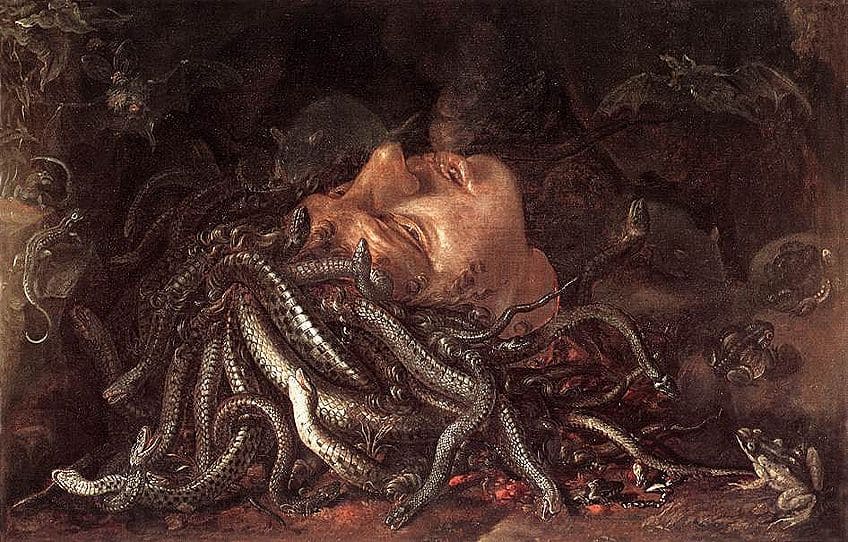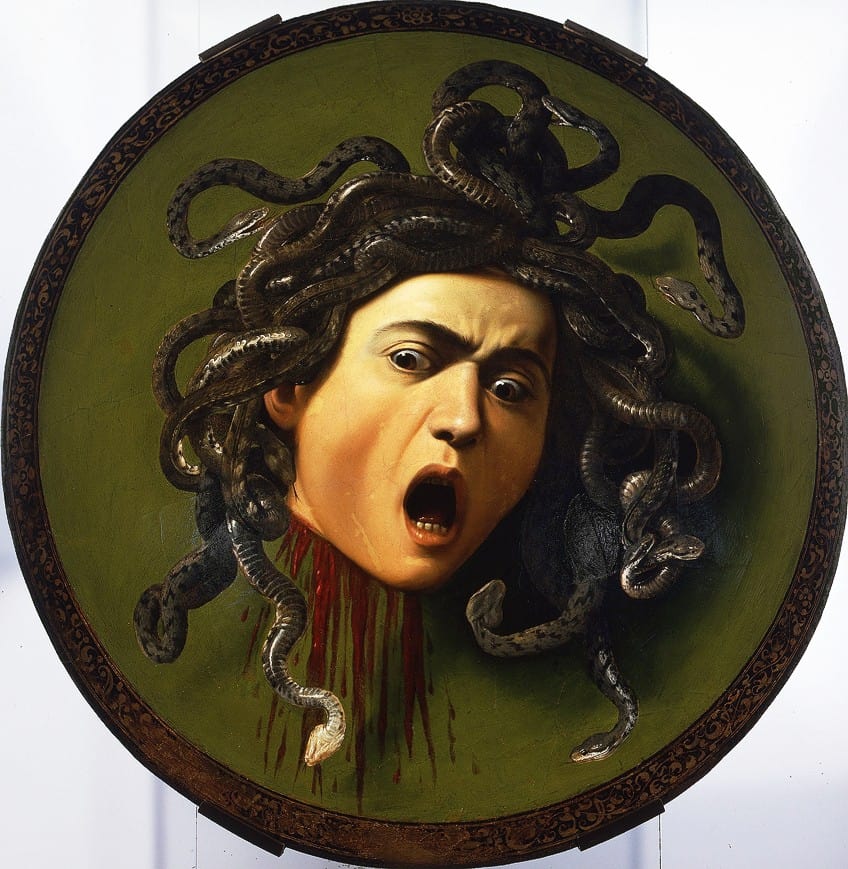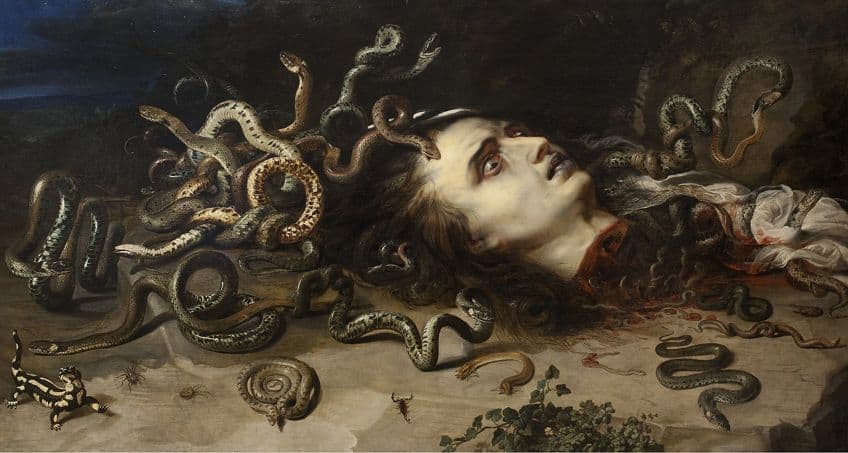Famous Medusa Paintings – Staring Straight at Iconic Medusa Art
Reproduced across Classical and Hellenistic Greek art, as well as European Baroque art, sculpture, and Modern-day Contemporary popular culture, the ubiquitous mythological image of Medusa haunts and questions its role in art history. In this article, we will explore the different representations of Medusa in art history by venturing in time through some of the most famous Medusa head paintings in art history. Read on for more!
Representing Medusa in Art History
Who is Medusa? And what is her story? There are many popular Medusa drawings and paintings that feature the famous Greek Gorgon and capture her story from different angles. Before we dive into the most famous Medusa paintings, let us first review who this popular character is and how her story has been historicized in art history. Medusa is commonly identified in popular culture as the iconic woman with a head full of snakes and menacing eyes that would turn you into stone. Across mythology, there are numerous variations in her story that all end with her death at the hands of Perseus.
Recognized as a Greek Gorgon, Medusa has been a popular subject in art since the era of antiquities in ancient Greece. For centuries, artists have been inspired by her striking image and myths surrounding her character. Medusa’s face appears in many mediums, including jewelry, drawings, sculpture, pottery, painting, relief carving, and decorative art objects.
According to a common narrative from Greek mythology, Medusa is often described as the daughter of Ceto and Phorcys, who were Chthonic “monsters” from an “archaic” world. She had two sisters, Stheno and Euryale, and was the only Gorgon daughter who was mortal. The story only darkens as the narrative unfolds. As many may not be aware, Medusa was once described as a fair young maiden whose hair turned into snakes after she was raped by Poseidon in the temple of the goddesses.

The symbol of the snake differed in art history and was first seen as evil by Christians due to its affiliation with sin and the devil and was interpreted as representative of immortality and fertility by the Greeks and near eastern cultures. Medusa was murdered by Perseus who was a heroic Greek figure ordered by King Polydectes to bring back Medusa’s head to Seriphus. Medusa’s life was thrust into the balancing act of a challenge by a powerful authority, out of her control. The challenge was brought up only because Polydectes sought to marry Perseus’ mother. The Greek Gods assisted Perseus with the challenge by giving him a shield with a mirrored surface from Athena, an invisible helmet from Hades, winged footwear from Hermes, and a sword from Hephaestus.
With the help of the Greek gods, Medusa was beheaded by Perseus with the primary assistance of the mirrored shield, which helped Perseus to see Medusa in the reflection and avoid turning it into stone. What makes the myth even more so tragic was that Medusa was pregnant with Poseidon’s child from the attack. Perseus then carried Medusa’s head and presented it to Athena for mounting on her shield.
A poem by English poet Carol Duffy on Medusa draws attention to the acts of violence inflicted on women and the historical pattern of many who engage in victim blaming. The latter part of her poem as quoted reads: “And here you come with a shield for a heart and a sword for a tongue, and your girls, your girls. Wasn’t I beautiful? Wasn’t I fragrant and young? Look at me now.” Medusa was caught in a losing battle against seemingly heroic figures, a king, and a band of Greek Gods who served her punishment for Poseidon’s crimes. Medusa’s transformation into a Gorgon was the result of a horrendous crime against her and in the end, she was still murdered in her sleep as part of a challenge. Below, we will examine a few interesting Medusa head paintings that portray the mythological figure in different manners and showcase the imaginative abilities of creatives from the 16th to the 20th centuries.
The Top Seven Most Famous Medusa Paintings in Art History
Now that you have an in-depth background of the mythology of Medusa as well as the events that led to her death, we can now explore some of the creative ways that artists have depicted Medusa in their artwork. Below, we have compiled a list of the top seven Medusa head paintings in art history that you will find incredibly fascinating! At the end, we have also listed a few famous Medusa drawings that are useful for comparison when looking at these paintings.
Medusa-Murtola (1596) by Caravaggio
| Artist Name | Michelangelo Merisi da Caravaggio (1571 – 1610) |
| Date | 1596 |
| Medium | Oil on canvas mounted on wood |
| Dimensions (cm) | 48 x 55 |
| Where It Is Housed | Private collection |
Medusa-Murtola is one of the most famous Medusa paintings in art history, dating to the late 16th century. The painting was created by the famous Baroque painter Michelangelo Merisi da Caravaggio who was just as eccentric as his paintings. A master of extreme human expression, Caravaggio chose to represent the image of Medusa at the moment of her beheading, suspending her face in the liminal space between life and death. The painting is an original to Caravaggio’s other Medusa painting, which was created shortly after this one. The painting is currently in the holds of a private collection while the other Medusa painting can be seen at the Florence Uffizi Gallery.
The painting’s title gained its name from a 16th-century poet called Gaspare Murtola, who penned the phrase “Flee, for if your eyes are petrified in amazement, she will turn you to stone”, made about Medusa.
The expression painted on Medusa’s face is a haunting expression that brings the image of her snake-infested hair to life as well as the fact that she has just been beheaded (seen in the spouting blood). Caravaggio was an expert at depicting intense emotions and truly immortalized Medusa in her moment of interrupted wake in the face of injustice.
The gruesome image is haunting yet it became a motif of war since Medusa’s power was so strong that in the aftermath of her death, her head still carried the power to turn her viewers into stone.
Medusa (1597) by Caravaggio
| Artist Name | Michelangelo Merisi da Caravaggio (1571 – 1610) |
| Date | 1597 |
| Medium | Oil on canvas mounted on wood |
| Dimensions (cm) | 60 x 55 |
| Where It Is Housed | Uffizi Gallery, Florence, Italy |
Similar to the first Medusa painting, Medusa was Caravaggio’s second creation that echoes the creative flexibility of the artist himself and his investment in the legend and art production. As in Medusa-Murtola, Caravaggio inserts the image of his face into the image of Medusa and blends the two to add a further level of engagement with the image and myth of Medusa. By identifying himself with Medusa, thus becoming her, he reinforces the idea that he is protected from her gaze because he has transformed himself into the wielder of such power.
The expression is also noteworthy since Caravaggio captures Medusa’s perceived expression at the moment that she knew she was about to be murdered. Medusa’s silent scream is also highlighted in her open mouth, painted with an expression of shock, anger, and disbelief at the rude atrocity.

Caravaggio thought ahead a step further and averted Medusa’s gaze to transfer the power to the viewer, thus making the viewer feel “safe”. In 1598, a Medusa painting was commissioned by Cardinal Francesco Maria Del Monte who was an agent for the Medici family in Rome. Much can be discussed about the technical execution of the painting, which emphasizes Caravaggio’s genius in fooling the viewer into believing that the convex surface is concave.
It is also believed that the painting was prompted by a document emerging from 1568, which stated that a Medusa painting on a shield was also created for the collection of the Grand Duke and was probably the primary reason why Caravaggio was prompted in the first place.
Head of Medusa (c. 1617 – 1618) by Peter Paul Rubens
| Artist Name | Sir Peter Paul Rubens (1577 – 1640) |
| Date | c. 1617 – 1618 |
| Medium | Oil on canvas |
| Dimensions (cm) | 69 x 118 |
| Where It Is Housed | Kunsthistorisches Museum, Vienna, Austria |
Head of Medusa is among the few remaining famous Medusa paintings in art history created by Sir Peter Paul Rubens in the early 17th century. The painting was a collaborative effort by both Rubens and fellow artist Frans Snyders, who contributed to the depiction of Medusa’s snakes. The painting is presently housed at the Vienna Kunsthistorisches Museum while another version exists in the Moravian Gallery in Czech.
One of the most striking aspects of Rubens’ and Snyders’ painting is the writhing snakes that leave Medusa’s severed head after her decapitation. The scene also takes place in a grim-looking landscape on a stone ledge.

Rubens offers an interesting depiction of her blood, which possesses a transformative ability as seen in the sudden appearance of vipers. The snakes which were once attached to her body react in multiple ways with some attacking each other and others giving birth to more snakes. The depiction of Medusa’s face also reflects an immediate sense of death made evident by her extremely pale face. The scene is both tragic and surreal. Rubens’ painting also reminds one of the varying interpretations of the Medusa myth that describe her as wicked in the face of Perseus, who stood to represent all forms of reason in mankind.
Medusa’s duality is sparked by the Head of Medusa, which leaves the viewer in suspense.
Medusa (c. 1878) by Arnold Böcklin
| Artist Name | Arnold Böcklin (1827 – 1901) |
| Date | c. 1878 |
| Medium | Oil on panel |
| Dimensions (cm) | 39 x 37 |
| Where It Is Housed | Germanisches Nationalmuseum, Nuremberg, Germany |
This famous painting of Medusa was created in the latter 19th century by Swiss artist Arnold Böcklin who was heavily influenced by the Romantic movement and formed his own approach by combining Symbolist images with scenes from mythology and influences of the pre-Raphaelite movement.
His paintings reflect an interpretation of his view on classical subjects, which can be seen in Medusa.

The panel painting touches on the strange or subliminal notion of death as experienced by the mythological figure, Medusa. His portrait of Medusa captures the imagined sense of the end of a life characterized by the use of dull, cool-toned, and muted colors, which relay the message of loss and mortality.
Even the snakes on Medusa’s head appear to rapidly lose their color.
The Barrel of Hate (c. 1899) by Carlos Schwabe
| Artist Name | Carlos Schwabe (1866 – 1926) |
| Date | c. 1899 |
| Medium | Watercolor and black ink wash on graphite trace on ivory-grained arch paper |
| Dimensions (cm) | 63.8 x 49.6 |
| Where It Is Housed | Musée d’Orsay, Paris, France |
Although not presently on exhibit, this famous Medusa artwork by Carlos Schwabe is one of the most famous Medusa watercolor paintings that portray Medusa in an incredibly rocky landscape while holding two heads in her hand. The painting also illustrates Medusa as an elderly woman who appears drenched in the blood of the women she recently beheaded.
In contrast to other paintings of Medusa by Schwabe that show her emotions mirrored in her snakes, this one presents the snakes with their mouths wide open as the elderly Medusa squints directly at the viewer.
The viewer is quickly thrown into the scene as a witness to the beheading as well as a glimpse into the former younger self of Medusa herself who was also beheaded. The Barrel of Hate shows viewers the concurrent emotion of shame that accompanies hate when a character like Medusa grapples with her past and the crimes committed against her.
The viewer is thus forced to stare down a barrel of hate and perhaps self-hate.
Wild Hunt (1899) by Franz von Stuck
| Artist Name | Franz von Stuck (1863–1928) |
| Date | 1899 |
| Medium | Oil on canvas |
| Dimensions (cm) | Painting: 95 x 67 and frame: 18.3 x 91.7 |
| Where It Is Housed | Musée d’Orsay, Paris, France |
La Chasse Sauvage, translated in English to The Wild Hunt, is a popular oil painting by German painter Franz Ritter von Stuck. The painting was created in 1899 and was modified by the artist in 1900 with the addition of the head of Medusa seen in the bottom right corner. The painting was purchased by the Musée d’Orsay in 1980 and has since remained one of the most famous Medusa paintings from the late 19th century.
The painting was recently exhibited at the Scuderie del Quirinale in Italy under an exhibition exploring hell. The painting was initially awarded to the Louvre Museum but then assigned by the Louvre to the Musée d’Orsay.

La Chasse Sauvage reflects how many perceived Medusa, as a villain who would easily fall among hellish-looking figures. A pale woman riding a horse in the background resembles the pale skin of Medusa in the foreground as both women appear shrieking and are reminiscent of the ill and quick manner of death that approached Medusa.
Portrait of Tadeusz Błotnicki with Medusa (1902) by Jacek Malczewski
| Artist Name | Jacek Malczewski (1854 – 1929) |
| Date | 1902 |
| Medium | Oil on oak |
| Dimensions (cm) | 46 x 37.5 |
| Where It Is Housed | Muzeum Narodowe w Warszawie, Warsaw, Poland |
Another Symbolist fan of Medusa, Polish painter Jacek Malczewski included Medusa in Portrait of Tadeusz Błotnicki with Medusa, which portrays the sculptor Tadeusz Błotnicki in a fearful yet calm disposition while in the company of Medusa. The depiction of Medusa is much softer and shows off her auburn locks alongside her slithering companions.
The portrait depicts Medusa as attempting to seduce the sculptor as he clutches for his dear life at the cross on his necklace. Malczewski painted Medusa’s eyes with a similar shade of luminescent emerald, green to that of the snakes as her eyes fixate on the sculptor.

The painting emulates the interpretation of Medusa’s character as vengeful of men and villainizes her character as a malicious Gorgon. Other fascinating Medusa artworks that you can browse through in your spare time include famous Medusa drawings such as Head of Medusa (1680) by Godfried Maes, Perseus and the Sleeping Medusa (1779) by Alexander Runciman, and Medusa (1897) by Lucien Lévy-Dhurmer.
The image of Medusa has shifted over the centuries to include her character in many popular culture films. The role of ancient narratives such as Medusa in Greek mythology and its translation into art played a huge role in influencing the common interpretation of Medusa as an evil, villainous figure. In reviewing these Medusa artworks, one can arrive at alternative interpretations that speak to recurring issues such as gender-based violence and the injustices against women. We hope that these insights can help you reframe your perception of ancient narratives and inspire you to write your own!
Frequently Asked Questions
Who Is Medusa?
Medusa is a mythical character from ancient Greek mythology, who was transformed into a mortal Gorgon with the power to turn individuals into stone with her gaze. Medusa was beheaded by Perseus, who was challenged by King Polydectes. Medusa was also cursed by Athena after she was raped by Poseidon.
What Is the Most Famous Medusa Painting?
The most famous Medusa painting is considered to be the 1598 painting Medusa by Caravaggio, with its earlier version in 1596 that represents the head of Medusa on a shield.
What Does Medusa Represent in Art?
One of the most common meanings behind the image of Medusa in art involves her image acting as an apotropaic symbol that is leveraged to ward off evil and was recognized as an ancient evil eye. Her image is often associated with evil and as such, her image was adopted as a symbol to fight evil with evil. Other representations of Medusa in art include mortality, death, women in power, and fatal beauty.
Jordan Anthony is a Cape Town-based film photographer, curator, and arts writer. She holds a Bachelor of Art in Fine Arts from the University of the Witwatersrand, Johannesburg, where she explored themes like healing, identity, dreams, and intuitive creation in her Contemporary art practice. Jordan has collaborated with various local art institutions, including the KZNSA Gallery in Durban, the Turbine Art Fair, and the Wits Art Museum. Her photography focuses on abstract color manipulations, portraiture, candid shots, and urban landscapes. She’s intrigued by philosophy, memory, and esotericism, drawing inspiration from Surrealism, Fluxus, and ancient civilizations, as well as childhood influences and found objects. Jordan is working for artfilemagazine since 2022 and writes blog posts about art history and photography.
Learn more about Jordan Anthony and about us.
Cite this Article
Jordan, Anthony, “Famous Medusa Paintings – Staring Straight at Iconic Medusa Art.” artfilemagazine – Your Online Art Source. March 29, 2023. URL: https://artfilemagazine.com/famous-medusa-paintings/
Anthony, J. (2023, 29 March). Famous Medusa Paintings – Staring Straight at Iconic Medusa Art. artfilemagazine – Your Online Art Source. https://artfilemagazine.com/famous-medusa-paintings/
Anthony, Jordan. “Famous Medusa Paintings – Staring Straight at Iconic Medusa Art.” artfilemagazine – Your Online Art Source, March 29, 2023. https://artfilemagazine.com/famous-medusa-paintings/.



